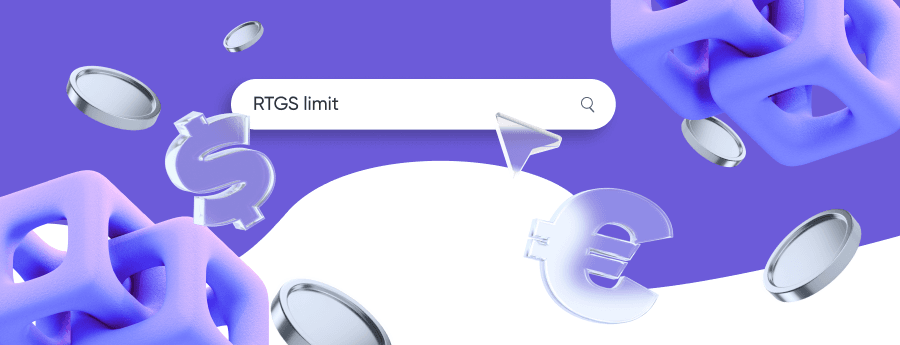If you're considering a high-value bank transfer in India, understanding the RTGS (Real Time Gross Settlement) limits is crucial. RTGS allows for immediate, gross (individual) transfers between banks, making it the ideal method for large-value transactions. Below is a guide to help you understand the daily transfer limits, the minimum and maximum transfer amounts, and how to increase your limit.
Real Time Gross Settlement Daily, Minimum and Maximum Transfer Limits
The daily RTGS limit varies by bank and is determined by the Reserve Bank of India (RBI). While the RBI sets certain minimum guidelines, individual banks have their own upper limits. The typical minimum transfer amount for RTGS transactions is 2 INR lakh. However, there's no fixed maximum limit — banks set their own caps based on factors like the account type and transaction method. To enhance security, some banks impose stricter limits depending on account type or the channels used.
What Is the RTGS Limit Per Day?
The RTGS limit per day is usually, by each institution, depending on customer category and banking channel. Although at some banks, personal accounts are subject to up to 50 INR lakh, business accounts could be even more lenient. In particular cases, premium account holders can have enhanced transfer limits according to the greater transaction needs they have.
What Is the Minimum Amount for an RTGS Payments?

The minimum amount for an RTGS transfer is 2 INR lakh. Minimum limits set by banks could be adjusted occasionally with changing financial regulations.
What Is the Maximum Limit for RTGS Transfer?
Although no ceiling is put on the number of RTGS transactions by the RBI, the banks may set their own ceiling. For example, HDFC Bank has an average upper limit of 50 INR lakh for online payments. Larger deposits may have to be deposited at branches and/or be subject to verification. Sometimes, banks would require a higher KYC level or some extra paperwork when higher credit limits are requested.
RTGS Transfer Limit Set by Top Banks in India
RTGS transfer limits vary across Indian banks, depending on factors like account type and the method of transfer. Some banks may offer higher limits for online transactions, while others might have more generous limits for in-branch transactions. Below are the RTGS limits set by some of India's top banks. These limits are designed to ensure secure, efficient processing of high-value transactions. If your transfer exceeds these limits, you may need to visit the branch, use alternative methods like RTGS via cheque, or request an increase in your limit.
RTGS Limit in HDFC Bank, SBI, ICICI, and Axis
RTGS transfer limits can vary significantly across different banks. While private sector banks like HDFC and Axis generally offer higher transfer limits, public sector banks such as SBI may impose lower limits for online transactions.
It is always recommended to check the official bank website for the latest information.
RTGS Transaction Limit: Online Banking vs Cheque
Online Banking:
When conducting RTGS transactions through online banking, the daily limits are typically lower. This is due to security measures like encryption and OTP authentication, which help prevent cyber fraud. The use of online channels is generally capped to ensure a secure and controlled transfer environment.
Cheque:
In contrast, cheque-based RTGS transactions usually allow larger amounts. Since cheques go through manual verification, which includes more thorough checks by bank staff, banks can afford to offer higher limits. As a result, cheque transactions tend to have fewer restrictions, enabling bigger transfers compared to online banking.
RTGS Limit for First-Time Beneficiary Transfers
When adding a new beneficiary, banks often impose a lower transfer limit initially as a precaution against fraud and unauthorized transactions. This temporary limit serves as a security measure while the bank verifies the beneficiary's account. During this period, the bank monitors transactions to ensure their legitimacy. Once the beneficiary’s details are confirmed, the transfer limit may be gradually increased. This helps protect both the sender and recipient from potential fraud or financial risks.
How to Increase Your RTGS Limit: Step-by-Step Guide
To raise your RTGS transfer limit, it is important to obtain the right procedures, which might slightly differ from bank to bank. Almost all financial institutions will let you increase their limits via their online banking platforms or phone apps. This is an easy process and takes only a few minutes. For more detailed information on RTGS transactions, you can visit the Paykassma blog, which offers valuable insights into various banking processes, including what is payment processing. Below is a general step-by-step guide to assist you:
- Log in to your online banking portal.
- Navigate to the fund transfer settings.
- Select RTGS limit increase.
- Enter the desired limit and authenticate using OTP or password.
Besides being quick, electronically raising your RTGS limit will guarantee that your transactions will remain secure and effective. You can always go to your local bank branch for help if the online one fails. Do not forget to have your account details and identification documents close at hand to avoid wasting time.
Using Mobile App or Net Banking to Increase RTGS Limit
Many banks offer the option to increase limits directly via their mobile apps. Look for the limit settings under the fund transfer section and follow the steps similar to online banking.

Visiting a Bank Branch to Change the Fund Transfer Limit
If you're unable to use online methods, you can visit your bank branch to request the limit increase. Ensure you carry necessary documents such as your ID proof and account details. Please note that this process may take a few hours to reflect in the system.
Required Documents, IFSC Code, and Verification Time
To increase the RTGS limit, you may need to provide:
- ID proof (Aadhaar, PAN);
- Account details;
- IFSC code.
Verification time can vary from a few minutes if done online to a few hours at the branch, depending on the bank’s process.
Timings, Settlement, and Security in RTGS Transactions
RTGS transactions are processed in real time during banking hours, ensuring immediate settlement between banks. Typically, RTGS is available from 8:00 AM to 6:00 PM, although the exact hours may vary slightly depending on the financial institution.
For a detailed explanation of how quickly RTGS transfers are processed and what might affect that speed, check our guide on time taken for rtgs transfer.
In terms of security, RTGS transactions are safeguarded with encryption and OTP (One-Time Password) verification, ensuring protection against unauthorized access. According to Paykassma, its robust security framework has been a key factor in maintaining the credibility and trustworthiness of these transactions.
Real-Time Processing and Gross Settlement Explained
RTGS operates on a real-time, gross settlement system, meaning each transaction is cleared individually and settled immediately—there's no waiting time involved. This differs from NEFT (National Electronic Funds Transfer), which batches transactions and settles them at hourly intervals. By processing each transfer as it occurs, RTGS reduces the risk of delays and ensures a more efficient transfer process.
How RTGS Ensures Safe and Instant Online Transactions
RTGS transactions are secure thanks to PCI compliance certification, the implementation of two-factor authentication, and the use of unique IFSC codes. These measures protect sensitive financial data, making RTGS an ideal solution for high-value, business-critical payments. In addition, most banks also partner with platforms such as Paykassma that educate users about online payment security methods, further enhancing the security of online RTGS transactions.
Online Payment Company #1
Online payment solutions for all types of businesses since 2019
Subscribe to stay updated
on industry news, insights, and exclusive offers


